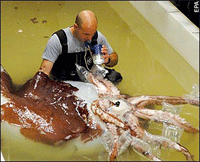Colossal Squid Has Largest Eye Ever Seen
Daily News Article — Posted on April 30, 2008
 (by Nick Squires, April 30, 2008, Telegraph.co.uk) Sydney, AUSTRALIA –
(by Nick Squires, April 30, 2008, Telegraph.co.uk) Sydney, AUSTRALIA –
Scientists in New Zealand have been unlocking the secrets of a 32ft-long Colossal squid caught by fishermen last year in Antarctic waters.
An international team of scientists started examining the larger squid after thawing it out in a tank filled with cold salty water at The Museum of New Zealand in Wellington.
Believed to be a female, it has been on ice since being accidentally netted by a trawler in the Ross Sea, hundreds of miles south of New Zealand in February 2007.
Although the biggest and best preserved squid ever caught, weighing in at 1,089lbs, scientists concluded that it was not fully grown because of the size of its beak, which slowly emerged as the surrounding flesh defrosted.
“[It] is certainly not the largest specimen out there,” said marine biologist Steve O’Shea, from the Auckland University of Technology. “Perhaps the Colossal squid gets up to 750kg [1,650lbs].”
By extrapolating the measurements of the squid’s beak and comparing it to beaks found in the stomachs of sperm whales, the researchers believe that the largest Colossal squid (Mesonychoteuthis hamiltoni) could reach up to 46ft in length.
“Can we assume that this species reaches three quarters of a ton in weight?” the museum’s projects manager, Chris Paulin, asked on a museum blog.
The squid has hundreds of sharp hooks on its arms as well as a large and powerful beak which could easily snap the backbone of a fish up to six feet long, said Dr O’Shea. “It’s endowed with a killer arsenal: the hooks, the beak, everything about it.”
The scientists measured the creature’s eyes and found them to be nearly 11 inches wide – larger than a dinner plate and the biggest of any animal in the world.
“This is the largest eye ever recorded in history and studied,” said Swedish professor Eric Warrant of the University of Lund, who specializes in vision in invertebrates. “It has a huge lens the size of an orange and captures an awful lot of light in the dark depths in which it hunts.”
Researchers hope their examination will teach them a great deal about the mysterious squid, an aggressive predator which feeds on fish and can descend to 6,500 feet.
Its tentacles have swiveling hooks to snare prey and, further up the limb, fixed hooks with three razor points help it hold onto large prey as they are sliced into thumb-sized pieces for swallowing.
The colossal squid’s chief predator is believed to be the sperm whale.
The squid will be measured and tested before being preserved in formaldehyde for display at the museum later this year.
The progress of the examination was shown via webcams on the museum’s website http://www.tepapa.govt.nz.
Information appearing on telegraph.co.uk is the copyright of Telegraph Media Group Limited and must not be reproduced in any medium without licence. Reprinted here for educational purposes only. May not be reproduced on other websites without permission from the Telegraph. Visit the website at telegraph.co.uk.
